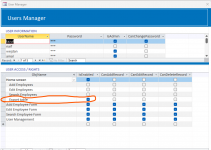smtazulislam
Member
- Local time
- Today, 07:35
- Joined
- Mar 27, 2020
- Messages
- 808
Hello,
I've developed an HRM database where I aim to establish a comprehensive User Control and Permission System, delineating who can edit and who can only view data.
Currently, I've implemented separate forms for each department, incorporating additional enable/disable functionality from a main form with specific conditions.
Managing this setup has become cumbersome due to the multitude of form and control names, making it challenging to remember each details. I'm seeking advice on a more streamlined approach to control permissions, ideally using TextBoxes to facilitate easier management.
Here is provided still work on with control Dashboard only
Can I establish a system where permissions for a form (like frmAddEmployee) can Edit/View/Delete/Addition give permission based on the UserRoles. Moreover, can I extend this control to individual textboxes within the form.
I appreciate any guidance or recommendations and simplicity of my user control and permission system.
Thank you
I've developed an HRM database where I aim to establish a comprehensive User Control and Permission System, delineating who can edit and who can only view data.
Currently, I've implemented separate forms for each department, incorporating additional enable/disable functionality from a main form with specific conditions.
Managing this setup has become cumbersome due to the multitude of form and control names, making it challenging to remember each details. I'm seeking advice on a more streamlined approach to control permissions, ideally using TextBoxes to facilitate easier management.
Here is provided still work on with control Dashboard only
Code:
Private Sub Form_Load()
DoCmd.Maximize
''Control User Roles
Dim StrUserRole As Integer
StrUserRole = DLookup("UserRolesID", "Users", "UserName='" & TempVars("UserName") & "'")
Select Case StrUserRole
Case 1 'admin
Me.lbAddEmployee.Enabled = True
Me.lbEditEmployee.Enabled = True
Me.lbSearchEmployee.Enabled = True
Me.lblViewAll.Enabled = True
Me.lbHireEmployee.Enabled = True
Me.lbTransferEmployee.Enabled = True
Me.lbUpdatePassport.Enabled = True
Me.lbStopSalary.Enabled = True
Me.lbAdminPanel.Enabled = True
Case 2 'HR Supervisor
Me.lbAddEmployee.Enabled = True
Me.lbEditEmployee.Enabled = False
Me.lbSearchEmployee.Enabled = True
Me.lblViewAll.Enabled = True
Me.lbHireEmployee.Enabled = True
Me.lbTransferEmployee.Enabled = True
Me.lbUpdatePassport.Enabled = False
Me.lbStopSalary.Enabled = True
Case 3 'payroll
Me.lbAddEmployee.Enabled = False
Me.lbEditEmployee.Enabled = False
Me.lbSearchEmployee.Enabled = True
Me.lblViewAll.Enabled = True
Me.lbHireEmployee.Enabled = False
Me.lbTransferEmployee.Enabled = False
Me.lbUpdatePassport.Enabled = False
Me.lbStopSalary.Enabled = True
Case 4 'Guest
Me.lbAddEmployee.Enabled = False
Me.lbEditEmployee.Enabled = False
Me.lbSearchEmployee.Enabled = True
Me.lblViewAll.Enabled = True
Me.lbHireEmployee.Enabled = False
Me.lbTransferEmployee.Enabled = False
Me.lbUpdatePassport.Enabled = False
Me.lbStopSalary.Enabled = True
Case 5 'HR Admin
Me.lbAddEmployee.Enabled = False
Me.lbEditEmployee.Enabled = False
Me.lbSearchEmployee.Enabled = True
Me.lblViewAll.Enabled = True
Me.lbHireEmployee.Enabled = False
Me.lbTransferEmployee.Enabled = False
Me.lbUpdatePassport.Enabled = False
Me.lbStopSalary.Enabled = True
Me.lbAddVacation.Enabled = False
Me.lblFinalExit.Enabled = False
Me.lbReports.Enabled = False
Me.lbUtilityPanel.Enabled = False
Case 6 'Maint Admin
Me.lbAddEmployee.Enabled = False
Me.lbEditEmployee.Enabled = False
Me.lbSearchEmployee.Enabled = True
Me.lblViewAll.Enabled = True
Me.lbHireEmployee.Enabled = False
Me.lbTransferEmployee.Enabled = False
Me.lbUpdatePassport.Enabled = False
Case 7 'Project Admin
Me.lbAddEmployee.Enabled = False
Me.lbEditEmployee.Enabled = False
Me.lbSearchEmployee.Enabled = True
Me.lblViewAll.Enabled = True
Me.lbHireEmployee.Enabled = False
Me.lbTransferEmployee.Enabled = False
Case 7 'Project Amdin
Me.lbAddEmployee.Enabled = False
Me.lbEditEmployee.Enabled = False
Me.lbSearchEmployee.Enabled = True
Me.lblViewAll.Enabled = True
Me.lbHireEmployee.Enabled = False
Me.lbTransferEmployee.Enabled = False
Me.lbUpdatePassport.Enabled = False
Me.lbStopSalary.Enabled = True
Case 8 'Finance Admin
Me.lbAddEmployee.Enabled = False
Me.lbEditEmployee.Enabled = False
Me.lbSearchEmployee.Enabled = True
Me.lblViewAll.Enabled = True
Me.lbHireEmployee.Enabled = False
Me.lbTransferEmployee.Enabled = False
Me.lbUpdatePassport.Enabled = False
Me.lbStopSalary.Enabled = True
Case 9 'Maint SuperVisor
Me.lbAddEmployee.Enabled = False
Me.lbEditEmployee.Enabled = True
Me.lbSearchEmployee.Enabled = True
Me.lblViewAll.Enabled = True
Me.lbHireEmployee.Enabled = False
Me.lbTransferEmployee.Enabled = True
Me.CmdOrderInbox.Enabled = False
Me.lbUpdatePassport.Enabled = False
Me.lbStopSalary.Enabled = True
Case 10 'Finance Supervisor
Me.lbAddEmployee.Enabled = False
Me.lbEditEmployee.Enabled = False
Me.lbSearchEmployee.Enabled = True
Me.lblViewAll.Enabled = True
Me.lbHireEmployee.Enabled = False
Me.lbTransferEmployee.Enabled = False
Me.lbUpdatePassport.Enabled = False
Me.lbStopSalary.Enabled = True
Case 11 'Project Supervisor
Me.lbAddEmployee.Enabled = False
Me.lbEditEmployee.Enabled = False
Me.lbSearchEmployee.Enabled = True
Me.lblViewAll.Enabled = True
Me.lbHireEmployee.Enabled = False
Me.lbTransferEmployee.Enabled = False
Me.lbUpdatePassport.Enabled = False
Me.lbStopSalary.Enabled = True
End Select
End SubI appreciate any guidance or recommendations and simplicity of my user control and permission system.
Thank you

